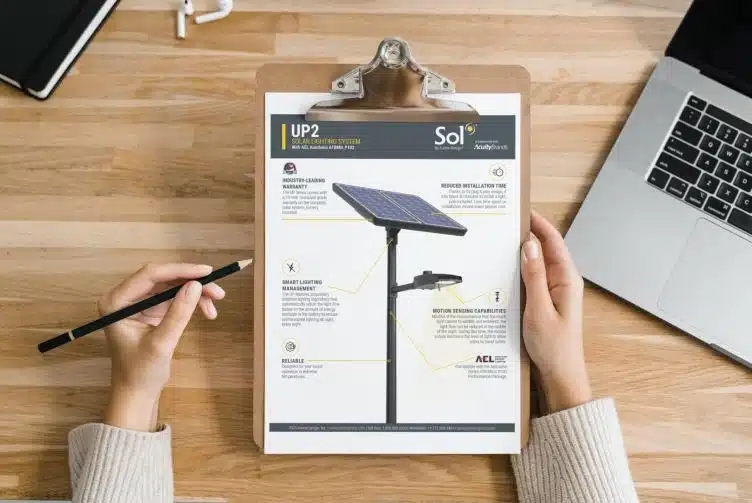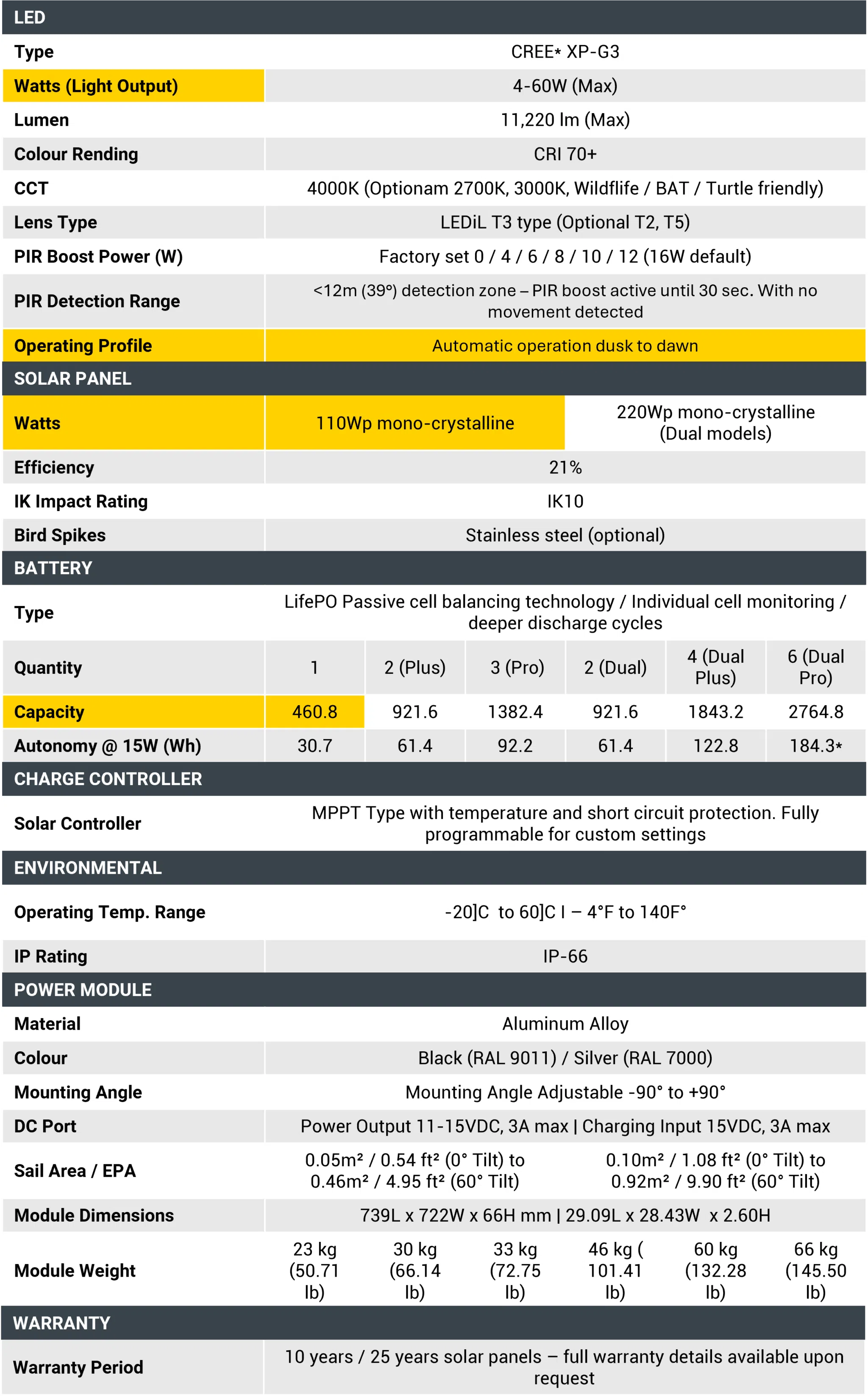Â
So, you’ve decided to use solar lighting for your next project. That’s a great move! But now comes the tricky part: choosing the right product and manufacturer.
Â
Shopping for solar lighting isn’t like buying an air fryer or a smartwatch. There's no one go-to resource like Wirecutter or CNET. Instead, you’ll often find yourself looking at spec sheets—those detailed documents that hold all the info you need to compare products and make an informed choice.
Â
But what exactly is a spec sheet? It’s a document that provides all the technical details about a product, including its performance, durability, and features. It can help you understand how different manufacturers stack up against each other, especially when it comes to things like warranties, certifications, and testing standards.
Â
Spec sheets are essential for anyone considering solar lighting, but they can be confusing if you don’t know what to look for. What do all those numbers mean? Which ones are most important? How can you tell if a product is really as good as it claims? We’re here to help you decode them!
Â
The key information you should focus on
Â
Here’s the good news: You don’t need to understand every detail on a spec sheet to make a smart decision. These documents are full of technical data, and not all of it will matter to you. However, there are four critical pieces of information that will determine whether a system will work for your project:
Â
- Solar panel size (in watt-peak – Wp)
- Fixture output (in watts – W)
- Battery capacity (in watt-hours – Wh)
- Operating profile or run-time (how long the system needs to run, and at what light level)
Â
You should be able to find these on most spec sheets. However, some manufacturers might leave out certain details to make their products seem better than they are. While missing info doesn't always mean something bad, it's worth asking questions if a company is unwilling to provide clear answers.
Â
Here’s an example of a spec sheet that includes all the necessary details:
Â
Â
With this data, you can perform simple calculations to see if a system will meet your project’s needs.
Â
Solar panel collection
Â
How big should the solar panel be? Start by finding the average number of peak sun hours your location receives during the worst month for solar insolation. The NREL’s PVWatts Calculator is a great tool for this.
Â
Let’s say your project is in Charlotte, NC, where the peak sun hours in December are 3.73 (with a 30° panel tilt). Multiply the peak sun hours by the panel size in watt-peak (Wp) to get the maximum daily charging capacity:
Â
3.73 x 110Wp = 410Wh
Â
This value assumes consistent sunlight, which rarely happens. That’s why it’s important to factor in an array-to-load ratio (ALR) to ensure the system can recover from low solar days. A common ALR is 1.2:1:
Â
410 / 1.2 = 341Wh
Â
If you skip the ALR, your system may work well in summer but fail in winter. Reputable manufacturers also apply derating factors to account for dust, snow, shade, and temperature changes. These aren’t usually listed on spec sheets, but they're worth asking about.
Â
Fixture output and operating profile
Â
You now know how much energy is available, but you still need to calculate how much is needed to power the fixture for the duration you require. Use NOAA’s Solar Calculator to find the longest night in your area.
Â
For our Charlotte example, it’s 14 hours. Find the fixture output (in watts) on the spec sheet. If your project has a lumen requirement, you can use efficacy (lumens per watt) to guide your selection.
Â
For instance, if you need 4,500 lumens and the fixture has an efficacy of 150LPW, you'll need at least a 30W fixture (4,500 / 150 = 30W). Multiply this by the longest night to get the daily load:
Â
30W x 14 = 420Wh
Â
This means the solar panels must be able to recharge 420Wh each day. In our example, the 110Wp panel would not be sufficient. To fix this, consider reducing the load by using a lower-wattage fixture or adjusting the operating profile.
Â
A 4D1 profile could reduce the load significantly, allowing the system to function properly.
Â
Battery capacity and chemistry
Â
Batteries are crucial for solar lighting systems. They determine whether a system lasts six months or several years. Different battery chemistries have varying capacities and lifespans.
Â
Lead acid batteries typically allow a 25% depth of discharge, while lithium batteries can go up to 70%. This affects how much energy you can safely use without damaging the battery.
Â
To calculate the minimum battery capacity, multiply the daily load by two (for two nights of autonomy), then divide by the depth of discharge:
Â
285Wh x 2 = 570Wh
570Wh / 0.7 = 814Wh
Â
If the battery capacity is too small, the system may fail after just a few days of poor weather. Always check the warranty and specifications carefully before making a purchase.
Â
Other important considerations
Â
Now that you understand how to size a solar lighting system, you can assess whether a product will work for your project. Before finalizing your decision, take a moment to review other aspects on the spec sheet.
Â
Warranty
Â
Even though federal funding may cover part of the cost, solar lighting is still a major investment. A solid warranty can give you peace of mind, ensuring you can return, replace, or repair a system if it fails.
Â
Most spec sheets list warranty details, such as a “5-year limited warranty†or “10-year warranty, excluding battery.†Be sure to check what is covered and whether the warranty is full or limited.
Â
Sol proudly offers a 10-year warranty on all its solar lighting systems, including the battery.
Â
Certifications and testing standards
Â
Certifications are a reliable way to verify a manufacturer’s claims. Look for certifications from independent bodies like IEC or IEEE. LM-79 testing, for example, measures LED performance and is a key indicator of quality.
Â
Read more about LM-79 and efficacy
Â
Fixture characteristics
Â
When evaluating fixtures, consider who made them. Some companies build their own, while others use third-party components. Both approaches have pros and cons, but the quality of the final product can vary widely.
Â
Working with established manufacturers like Acuity Brands ensures high-quality, durable fixtures that deliver consistent performance over time.
Â
Wrapping up
Â
Reading and comparing solar lighting spec sheets may seem challenging at first, but with the right knowledge, it becomes manageable. This guide should help you feel more confident in your choices and lead you to the best product for your needs.
Â
Have any questions about spec sheets or anything else? Our team of solar lighting experts is happy to help.
Â
Cnc Machining,Cnc Machining Parts,Precision Machining Link Part,Parts Machining
JING SUNG Precision CO., , https://www.jingsungcnc.com

